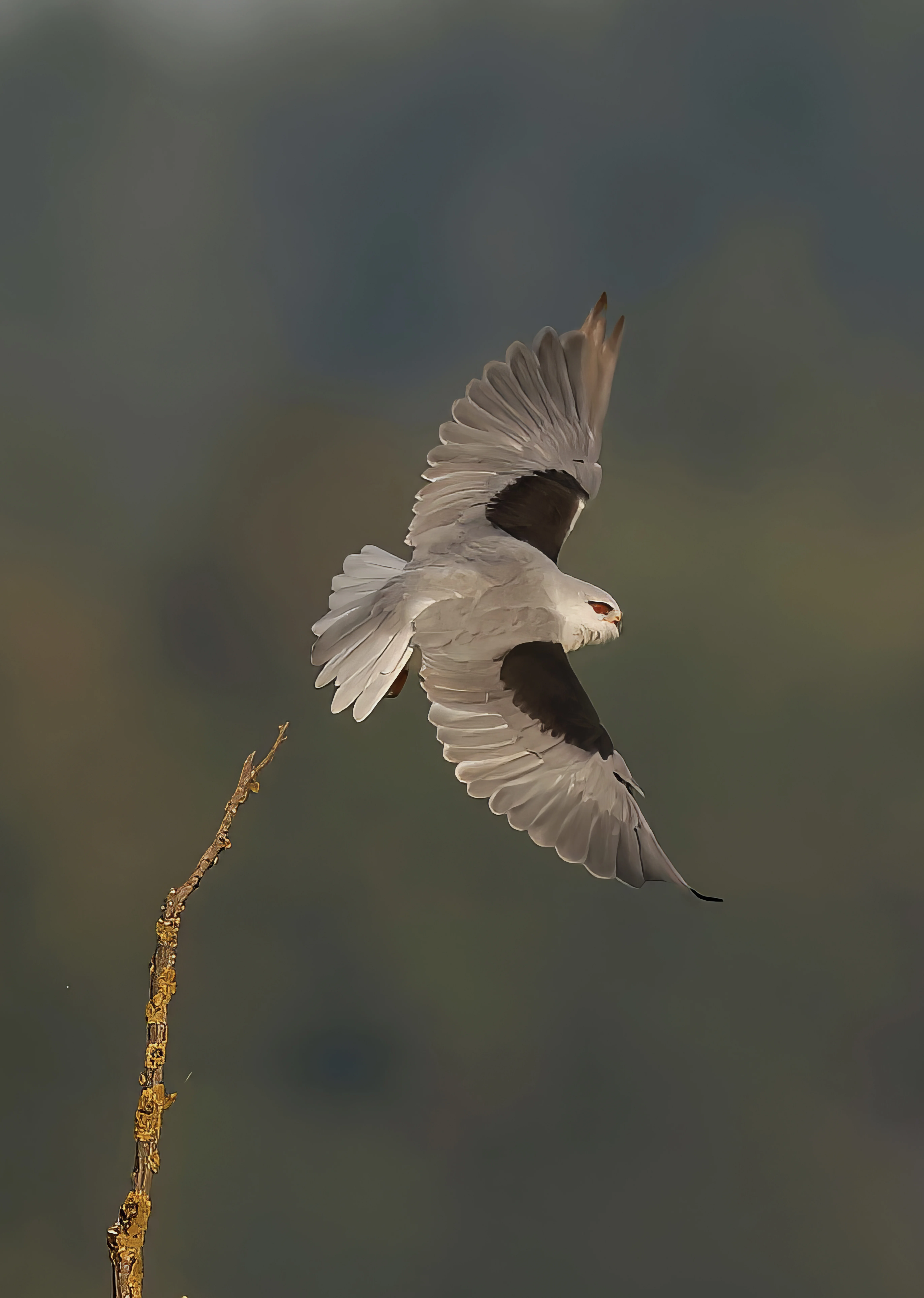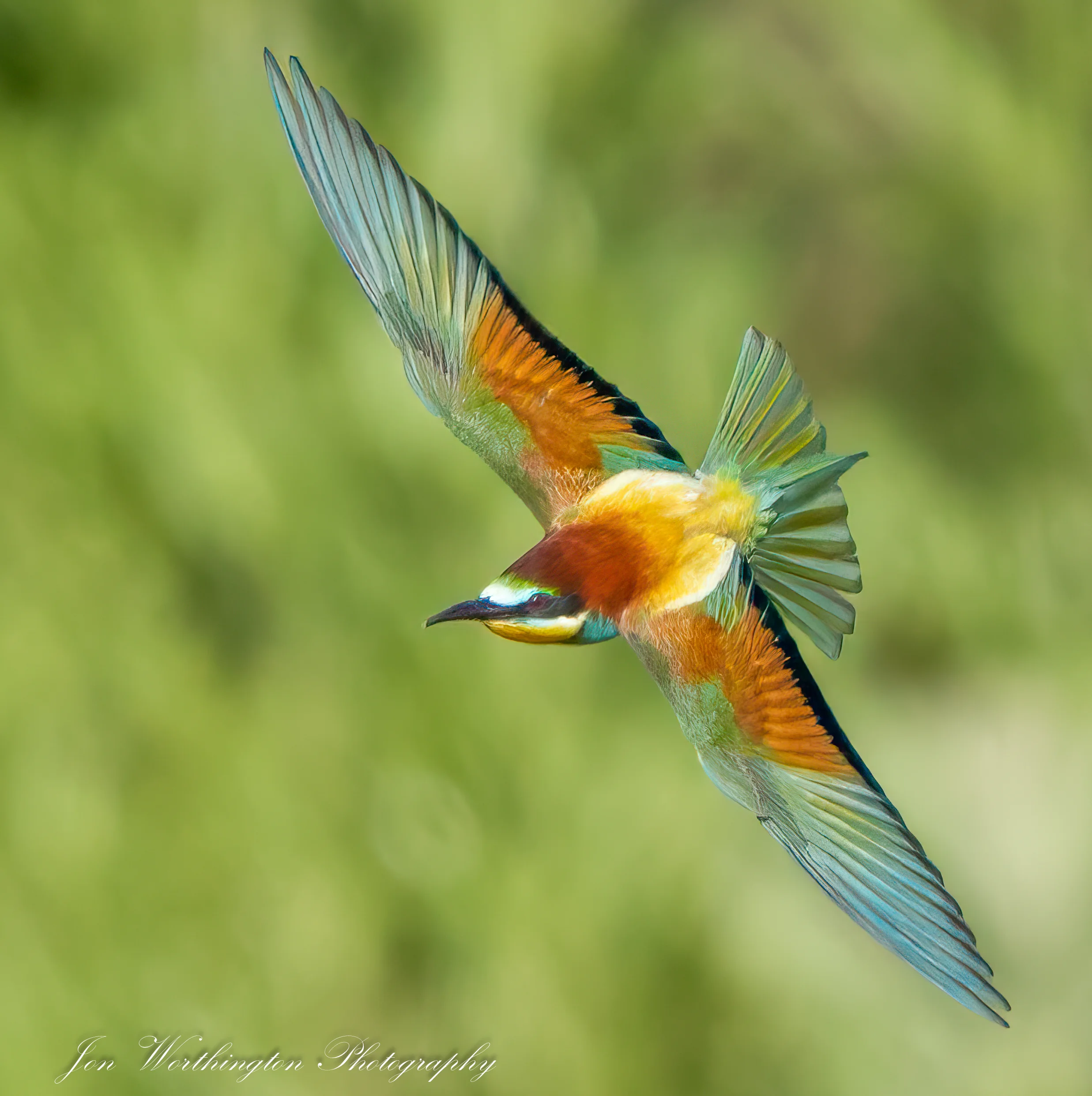After the long-anticipated British first Black-winged Kite in Powys in mid-April (see here), birders the length and breadth of Britain have kept a keen eye open for a potential reappearance. Following a 90-day blank, however, the trail had run cold, with hopes diminishing. Or so it seemed. On 17th, news broke of a Black-winged Kite seen late into the evening at Stubb Mill, Norfolk. More than 100 twitchers would take the gamble early the following day before it flew high north-west just after 9:30 am – and was later logged over the European Bee-eater watch site at Trimingham!

Black-winged Kite, King's Fleet, Suffolk (Adrian Webb).
Many more en route would disappointingly miss out, but they wouldn't have long to wait. It was back at Horsey, Norfolk, on 19-20th, before relocating to Felixstowe Ferry, Suffolk, that evening. Even more birders would gleefully enjoy the bird at sunrise the next morning, before it relocated south again, cropping up again at Colne Point, Essex, that night. After disappearing to the north-east on 22nd, the trail again went cold. Might Kent be the next county on its British tour? This distinctive raptor has been increasing its range throughout Europe for some time and, after two records already in 2023, we might not have too long to wait for a third.

Black-winged Kite, King's Fleet, Suffolk (Mike Alibone).

Black-winged Kite, King's Fleet, Suffolk (Chris Mayne).
Unfortunately, news of an orange-billed tern species in Devon took time to emerge – and was overshadowed somewhat by exciting events in East Anglia. Present late on 17th, it reappeared again briefly on 18-19th. It would have undoubtedly attracted more attention sooner if it had been broadcast as a probable Lesser Crested Tern, with observers settling on this as a likely outcome owing to an apparent grey rump, small size and a yellow (rather than orange) bill. While Britain has been treated to several Elegant Terns in recent years, the other likely species, Lesser Crested remains an incredibly rare visitor indeed, with the last record concerning one in Norfolk and Suffolk in July 2005.
Ireland's Caspian Tern count increased to two, with one at The Gearagh, Co Cork, from 20th – marking the first year with multiple Irish records since 2009. Amazingly, this is the fourth Irish record since 2020, yet the nation had only enjoyed 10 records (of 11 birds) previously. Others were in Northamptonshire, Nottinghamshire and Norfolk. A Gull-billed Tern or two were also on offer in Ireland, with birds at Kilkeran Lake, Co Cork, and Tacumshin, Co Wexford. The Least Tern lingered at Portrane, Co Dublin, too. The Dorset Forster's Tern again made an appearance, present near Arne RSPB in Poole Harbour on 21st and 23rd.

Caspian Tern, The Gearagh, Cork (Richard Mills).

Gull-billed Tern, Tacumshin, Wexford (Luke Geraty).
Bonaparte's Gulls were reported from Oare Marshes, Kent, and Lochaline, Highland, while a second-summer Baltic Gull was at a recycling centre in Widnes, Cheshire.

Forster's Tern, Arne RSPB, Dorset (Samuel Levy).
It was another excellent week of seawatching, culminating in high double-figure counts of Cory's Shearwater in the South-West Approaches – 91 off Galley Head, Co Cork, was the highest count. Six sites along the North Sea coast between East Yorkshire and Northumberland also enjoyed sightings. Smaller tallies of Great Shearwater were off six sites, with a notable example off Culbin Bar, Moray and Nairn. Rarest news of the week comprised a Barolo-type shearwater again off Porthgwarra, Cornwall, on 17th at least; even more notable still was a possible Short-tailed Shearwater past on 23rd. Pelagics out of Cornwall, Scilly and Co Cork enjoyed Wilson's Storm Petrels, with at least one in deep waters approximately 100 km north-west of St Kilda, Outer Hebrides. An adult Sabine's Gull was off Carnsore Point, Co Wexford, with a Long-tailed Skua off Brora, Highland.

Wilson's Storm Petrel, Scilly pelagic, Isles of Scilly (Joe Pender).
A pair of European Bee-eaters bred at an undisclosed site in Greater Manchester this summer, though are thought to have abandoned the nest and left the site by mid-week. Predation or internal collapse of the nest burrow is thought to be the cause. Unfortunately, the Trimingham, Norfolk, trio appear to have left the site over the weekend too. Others were in Cornwall and Suffolk.

European Bee-eater, Trimingham, Norfolk (Jon Worthington).
Headline news from Ireland saw the country's second Black-headed Wagtail at Myroe Levels, Londonderry, from 19th. A moulting adult male, it would remain until the week's end. Coincidentally, Ireland's first – at Lough Foyle in 2007 – was found less than 10 km away!
Black-headed Wagtail, Myroe Levels, Londonderry (Aaron Long).
A couple of European Serins were along the south coast, with Rosy Starlings still at Carradale, Argyll, and Voe, Mainland Shetland. The lingering Red-backed Shrike on North Ronaldsay, Orkney, was briefly joined by a Greater Short-toed Lark on 17th. Elsewhere, a Melodious Warbler was trapped and ringed at Nanjizal Valley, Cornwall, on 20th and a Marsh Warbler was at Bempton Cliffs RSPB, East Yorkshire. An Alpine Swift overflew Pendeen, Cornwall, on 19th, while European Honey Buzzards were in six counties.

Rosy Starling, Carradale, Argyll (Jim Dickson).
News of yet another successful Black-winged Stilt nesting attempt emerged this week, with a pair raising four young at Worth Marsh, Kent. A further two pairs at the site were unsuccessful. Other families remained at Frampton Marsh RSPB, Lincolnshire, and Edderthorpe Flash RSPB, South Yorkshire, with an additional male still in Gloucestershire.

Black-winged Stilt, Worth Marsh, Kent (Shane Vale).
Co Donegal's Black-winged Pratincole – only the second for Ireland – remained at Blanket Nook throughout. Equally welcome was a Pacific Golden Plover on the beach at Ballycotton, Co Cork, from 15-19th, the fourth county record. On North Ronaldsay, Orkney, meanwhile, photographic analysis from earlier in the month confirmed that the island hosted two different individuals over the course of five days – the observatory's 12th and 13th records.
We’ve highlighted a few features in the following photos, a bit thanks to those we have sent photos too, it’ll ultimately fall down to the rarities committee to judge if we are correct in our assessment. pic.twitter.com/8wqYzZSbF9
— North Ronaldsay Bird Observatory (@NRonBirdObs) July 23, 2023
A trio of American Golden Plovers abutted the Irish Sea, with dapper adult summers on Skokholm, Pembrokeshire, and at Tacumshin and Ballinoulart, Co Wexford. A Long-billed Dowitcher continued to provide excellent views at Leighton Moss RSPB, Lancashire, until 18th, with one still in Norfolk. Eight Pectoral Sandpipers were spread across the country and a brief Temminck's Stint visited Durham.

American Golden Plover, Skokholm, Pembrokeshire (Skokholm Warden).

Long-billed Dowitcher, Leighton Moss RSPB, Lancashire (Geoffrey Pain).
It was another impressive showing of Black-crowned Night Herons, with birds at 11 sites including a notable four at The Gearagh, Co Cork. Another delighted Scottish birders at Methil, Fife. The young Purple Heron was last noted at Gosforth Park, Northumberland, on 17th and unringed White Storks were in Surrey and Cambridgeshire.

Black-crowned Night Heron, The Gearagh, Cork (Richard Mills).
A pair of Ferruginous Ducks were fresh in at Draycote Water, Warwickshire, on 18th, continuing the West Midlands' intriguing run of records of the species in recent years. The Norfolk Lesser Scaup remained, as did three Ring-necked Ducks. The moulting drake American Wigeon was last reported in Lincolnshire on Monday, while seaduck interest concerned a Surf Scoter off Kinnaber, Angus, and the long-staying King Eider at Musselburgh, Lothian.
Western Palearctic
Significant news from Cape Verde saw the archipelago's first White-faced Whistling Duck at Santa Maria, Sal, on 23rd. A native of sub-Saharan Africa and South America, the species has occured as a likely wild vagrant to the Western Palearctic on just one previous occasion – one at Ayn Az Zarga, Libya, in September 2022.

White-faced Whistling Duck, Santa Maria, Sal (Uwe Thom).
An adult Brown Booby was on the south side of the English Channel off Île Rouzic, France, with a Sooty Tern delighting in a Sandwich Tern colony at L'Île-d'Olonne. Other notable reports comprised an Elegant Tern, Lesser Crested Tern, King Eider and Western Reef Heron.
Two Moroccan Wagtails highlighted in Spain at San Fernando, Andalucia, with a West African Crested Tern also in the province at Huelva. Galicia hosted a summer-plumaged adult Laughing Gull at Ons Island, with other news including an Elegant Tern, Lesser Crested Tern and Lesser Flamingo.
Denmark's sixth Zitting Cisticola was at Skagen from 20th, where a Steppe Eagle flew south-west on 17th. A first-summer Steppe Grey Shrike hung on at nearby Hirtshals, while a drake Stejneger's Scoter was still off Þvottárskriður, Iceland. A White-rumped Sandpiper at Pori was just the ninth for Finland and the first twitchable for 29 years.
A notable find in Eastern Europe concerned an Oriental Pratincole at Jász-Nagykun-Szolnok on 17th – a first for Hungary. It was first noted in the area on 4 June, but wouldn't be relocated and the identity confirmed until this week. Otherwise, Sociable Lapwing was at Paczkowski Lake, Poland, with a Caspian Plover at Lake Karla, Greece, and lingering Steller's Eider at Wesselburenerkoog, Germany. In Italy, an adult Grey-headed Gull continued at Pantani Longarini, Sicily.
Four Swinhoe's Storm Petrels were again off Eilat, Israel, while a Pied-billed Grebe remained on São Miguel, Azores.
- Keep up to date with by-the-minute sightings updates of rarities, migrants and birds in your local area at www.birdguides.com/sightings or via the BirdGuides app. New users are entitled to a one-month free trial.


